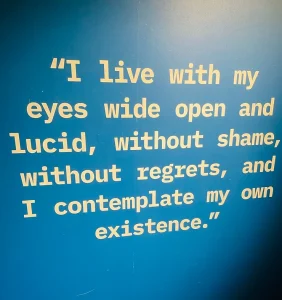During the easter weekend, I had the pleasure to visit an exhibition devoted to Salvador Dali's art called Dali: Cybernetics. The central part of the exhibition is the immersive world of the surrealist artist’s work. Initially seen through the old-style 3D glasses, and subsequently powered by a headset transporting you into the virtual world of Dali’s art. The intro to the exhibition reflects his varied interests in science, religion, photography and cybernetics, to name just a few.
Dali sought to unlock the unconscious mind and create art beyond reason and convention in his art. Freudian psychoanalysis profoundly influenced him, especially the unconscious and dream interpretation. Dali was introduced to Freud's work while he was still a student in Madrid, and later, he met the psychoanalyst in London in 1938. During their first and only meeting, Dali presented to Freud a painting called “The Metamorphosis of Narcissus”, which depicts the mythological figure of Narcissus. The myth says that Narcissus fell in love with his own reflection in a pool of water and ultimately died as a result of his love for his ideal self-image. In Dali’s painting, Narcissus is depicted as a hand holding an egg, reflected in the water below. The egg may represent the life potential, while the hand may represent the creative power. The painting is often interpreted as symbolic of desire, self-love, and the human psyche. This was Dali’s first painting made in accordance with the paranoic critical method or “spontaneous method of irrational knowledge”.
Dali also made a portrait of Freud, now part of the permanent collection at the Freud Museum in London. The painting depicts a bust-like portrait of Freud, supported by a crutch made from a piece of driftwood. The portrait is set against a barren landscape and is surrounded by other elements, such as ants crawling on the crutch and a grasshopper perched on the top of the portrait. The painting could be interpreted as Dali’s tribute to Freud’s role in the development of psychoanalysis and his influence on Dali’s own artistic vision.
Dali believed that the unconscious mind played a significant role in the creative process, and he often used surreal imagery in his paintings to explore the workings of the mind. He believed that by tapping into the unconscious, he could reveal hidden truths about the human experience. One of Dali's most famous works, "The Persistence of Memory," is thought to be heavily influenced by Freud's theories of the unconscious and the concept of the "dream state." The painting features melting clocks draped over objects in a barren landscape, with a distorted face in the background. The exact meaning of the painting is open to interpretation, and Dali himself provided several different explanations over the years. However, many art historians and critics believe that the painting is a meditation on the nature of time, memory, and mortality. The melting clocks in the painting are often interpreted as a symbol of the fluidity and subjectivity of time, which can be distorted and manipulated in the mind. The barren landscape may represent the transience and impermanence of human existence, while the distorted face in the background may symbolize memory's fragmented and unreliable nature. Overall, the painting is often seen as a commentary on the human experience of time and memory and how these concepts shape our understanding of the world. Its surreal imagery and dreamlike quality also suggest a deeper exploration of the workings of the unconscious mind, a major preoccupation of the Surrealist movement to which Dali belonged.

Dali's interest in psychoanalysis is also evident in his writings, including his autobiographical book, "The Secret Life of Salvador Dali," in which he describes his dreams and their role in his artistic process. Dali was particularly interested in the concept of the dream state, which he believed was a direct window into the unconscious mind. He often used dream-like imagery in his paintings, such as melting clocks and distorted landscapes, to represent the fluid and unpredictable nature of the unconscious.
Dali’s mental health was the subject of much speculation. He reportedly struggled with depression, anxiety, obsessions and compulsions, as well as paranoia and even hallucinations. Not all of those struggles can be confirmed, and Dali himself often exaggerated or embellished stories about his mental health for artistic and dramatic effect.

Despite those questions and some controversies surrounding Dali’s state of mind, there are things we could take from Dali to improve our quality of life:
- Mental health struggles can fuel creativity in some instances. Many art historians and psychologists believe these struggles partly fueled Dali’s art. Dali said, "The sole difference between myself and a madman is that I am not mad!". The takeout from Dali’s attitude towards his mental health could be that mental health struggles do not have to put limits on achieving great things.
- Art can be therapeutic. Dali used his art as a form of therapy throughout his life. He often referred to his art as a "medicine" that helped him cope with his mental health issues. We can learn from his example by using creative pursuits as a way to cope with our own mental health struggles.
- Self-expression can be healing. Dali was known for his eccentric personality and flamboyant style. He embraced his individuality and used self-expression to cope with his mental health issues. We can learn from his example by expressing ourselves freely and authentically, even if it initially feels uncomfortable.
- Seek help when you need it. Dali sought help from therapists and psychiatrists throughout his life. He recognised that he needed support and was unafraid to ask for it. We can learn from his example by seeking help when needed, whether talking to a therapist, reaching out to loved ones, or seeking other support.
Overall, Dali's fascination with psychoanalysis influenced his artistic style and helped shape his unique vision and approach to painting. Dali believed that the unconscious mind was a rich source of inspiration and creativity, and he often used surreal imagery in his paintings to explore its workings. He believed that by tapping into the unconscious, he could reveal hidden truths about the human experience and express the deepest parts of his own psyche.
At the same time, Dali recognised the dangers of the unconscious, particularly its potential to unleash destructive and violent impulses. He believed that the artist was responsible for channelling the unconscious positively and constructively, using it to express beauty, truth, and compassion. Overall, Dali's view of the unconscious was complex and nuanced, reflecting its potential for creativity and danger.
